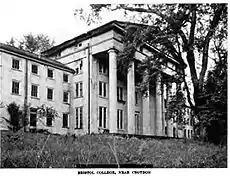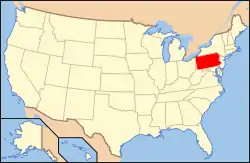Bristol College (Pennsylvania)
Bristol College was an Episcopal manual labor college located near Bristol, Pennsylvania. It was established on October 2, 1833, by the Episcopal Education Society of Philadelphia. The Rev. Chauncey Colton (1800–1876) was its only president. The institution closed in February 1837 for lack of financial support.
 | |
| Type | Private |
|---|---|
| Active | 1833–1837 |
| Founder | Episcopal Education Society of Philadelphia |
Religious affiliation | Episcopal Church |
| President | Rev. Chauncey Colton |
| Location | , |
| Campus | Rural |
White Hall of Bristol College | |
_03.JPG.webp) The remains of the 19th-century college in 2008 | |
 | |
| Location | 701-721 Shadyside Avenue in Croydon, Pennsylvania |
| Coordinates | 40°4′48″N 74°54′8″W |
| Area | 1.2 acres (0.49 ha) |
| Built | 1834 |
| Architect | A. J. Davis |
| Architectural style | Greek Revival |
| NRHP reference No. | 84003177 |
| Added to NRHP | January 12, 1984[1] |
History
The college was built on the banks of the Delaware River two miles from Bristol, Pennsylvania. The White Hall of the college, built by Alexander Jackson Davis in Greek Revival style, is on the National Register of Historic Places. Bristol College was used as a hospital during the American Civil War, and from 1868 through the 1880s as an orphanage for the children of colored soldiers.[2] The center columned section of the last remaining building, White Hall was condemned and later demolished in the 1980s. The East and West wings still stand and act as apartments.
Pennsylvania Literary, Scientific, and Military Academy
The Pennsylvania Literary, Scientific, and Military Academy was established on the former Bristol College building and grounds on September 5, 1842, by Captain Alden Partridge, and was conducted by him until April 1845, when it was discontinued and reopened at Harrisburg, on April 14th, of the same year. The academy was conducted by the graduates and past cadets of Norwich University. Henry V. Morris, served as the professor of Mathematics and Tactics from 1843 to 1845; Alvan E. Bovay was in charge of the Classical Department from 1843 to 1844; and Edward M. Brown was instructor of Mathematics from April 1844 to April 1845.[3]
Notable people
- Gregory Thurston Bedell Bishop of Ohio (Episcopal Church)
- William Muhlenberg Hiester
- Benjamin Chew Tilghman
- Richard Grant White literary scholar and critic (Father of Stanford White).
- William N. Pendleton faculty mathematics teacher, Episcopal priest, and Confederate Brigadier General during the U.S. Civil War
- John Celivergos Zachos U.S. Civil War Army Surgeon and Educator.
- Benjamin Blake Minor
References
- "National Register Information System". National Register of Historic Places. National Park Service. March 13, 2009.
- Lavoie, Catherine (October 3, 1990). "WHITE HALL OF BRISTOL COLLEGE - Data Pages" (PDF). Historical American Buildings Survey. National Park Service. Archived from the original (PDF) on December 17, 2013. Retrieved December 17, 2013.
- Dodge, Grenville Mellen; Ellis, William Arba (1911). Norwich University, 1819-1911; Her History, Her Graduates, Her Roll of Honor. Volume I: General History, 1819–1911. Montpelier, Vt.: Capital City Press. p. 397. OCLC 1049955565 – via Internet Archive.
 This article incorporates text from this source, which is in the public domain.
This article incorporates text from this source, which is in the public domain.
Further reading
- Joseph J. McCadden (1978). Education in Pennsylvania, 1801-1835 and Its Debt to Robert Vaux. Ayer Publishing. pp. 65–66. ISBN 0-405-01438-4.
- J.P. Wickersham (1969). History of Education in Pennsylvania. Ayer Publishing. pp. 424–425. ISBN 0-405-01491-0.
- A History of Bristol Borough in the County of Bucks, State of Pennsylvania by Doron Green 1911
External links
- White Hall of Bristol College, 701-721 Shadyside Avenue, Croydon, Bucks County, PA: 6 photos, 2 data pages, and 1 photo caption page at Historic American Buildings Survey
- Pennsylvania Colleges that have Closed, Merged, Changed Names

